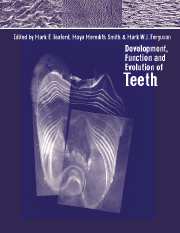Book contents
- Frontmatter
- Contents
- List of contributors
- Acknowledgements
- Part one Genes, molecules and tooth initiation
- Part two Tooth tissues: development and evolution
- Part three Evolution of tooth shape and dentition
- 10 Evolutionary origins of teeth and jaws: developmental models and phylogenetic patterns
- 11 Development and evolution of dentition patterns and their genetic basis
- 12 Evolution of tooth attachment in lower vertebrates to tetrapods
- 13 Tooth replacement patterns in non-mammalian vertebrates
- 14 The evolution of tooth shape and tooth function in primates
- 15 ‘Schultz's Rule’ and the evolution of tooth emergence and replacement patterns in primates and ungulates
- Part four Macrostructure and function
- Index
13 - Tooth replacement patterns in non-mammalian vertebrates
Published online by Cambridge University Press: 11 September 2009
- Frontmatter
- Contents
- List of contributors
- Acknowledgements
- Part one Genes, molecules and tooth initiation
- Part two Tooth tissues: development and evolution
- Part three Evolution of tooth shape and dentition
- 10 Evolutionary origins of teeth and jaws: developmental models and phylogenetic patterns
- 11 Development and evolution of dentition patterns and their genetic basis
- 12 Evolution of tooth attachment in lower vertebrates to tetrapods
- 13 Tooth replacement patterns in non-mammalian vertebrates
- 14 The evolution of tooth shape and tooth function in primates
- 15 ‘Schultz's Rule’ and the evolution of tooth emergence and replacement patterns in primates and ungulates
- Part four Macrostructure and function
- Index
Summary
Introduction
The complexities involved in the development of a mammalian tooth are slowly being unravelled. Involved in the epithelial-mesenchymal interactions are factors such as homeobox genes, growth factors and extracellular matrix molecules (Chapters 1–3). When one then attempts to project control mechanisms relating to the development of individual teeth to the ontogeny of the dentition as a whole, the topic indeed appears daunting. Not only has a tooth to develop, but it must also erupt into its correct position within the jaw. For most non-mammalian vertebrates (NMV), the teeth also are continually being replaced (polyphyodontism), involving resorption of the predecessors. Although teeth can be seen to undergo wear, tooth replacement is not a direct response to wear as, in animals such as the shark, replacement occurs too rapidly for wear to occur to any significant degree. As NMV generally grow throughout life, replacement is considered to be more related to this growth process as successional teeth erupt into progressively larger jaws. This is associated with progressively larger replacement teeth being formed (which may also exhibit a different morphology) and/or an increase in tooth number. Temporary gaps within the dentitions are usually apparent (Figure 13.1) and their extent will reflect the time interval between loss of a tooth and its replacement by a successor.
Apart from very rare examples, such as the piranha fish, the teeth of NMV do not occlude or shear past each other, and can only function in grasping the food, which is generally swallowed whole and head first. Assuming teeth play a role in the feeding mechanism, strategies will have evolved to ensure that the dentitions are suitably functional. In this context, the studies of Edmund have been particularly important in stimulating research into tooth replacement mechanisms.
- Type
- Chapter
- Information
- Development, Function and Evolution of Teeth , pp. 186 - 200Publisher: Cambridge University PressPrint publication year: 2000
- 35
- Cited by



